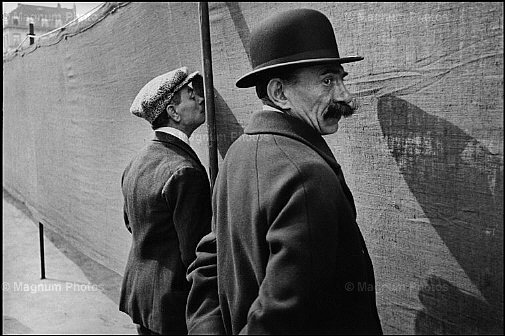
Within the next few weeks, we’re going to be bringing art dealer Elizabeth Heskin on board to educate us regular folks on collecting fine art. I tried to get her to write about affordable art for under $500, but she woke me out of my dream world.
Since I’ve been known to collect a photograph or two, I’ll get the ball rolling by sharing some tips on photographic prints. Keep in mind that I’m just a photographer, so I really know nothing about collecting.
I only buy black and white prints. It’s just my own personal preference. I’m not crazy about color and I won’t go near digital. In fact, I become really irate when I walk into a gallery that has digital images hanging on the wall. I feel cheated. Digital and fine art photography don’t mix! Unless it’s some funky Photoshopped image.
Prints should have been printed on fibre based paper or something that pre-dates that, unless you’re paying $50 for an RC or digital print at Union Square.
Some important factors to consider when parting with (much) more than $50:
Make sure you’re working with a reputable gallery.
Is this an established photographer?
Is the print signed?
Is the print part of an edition? Older photographers didn’t think of their work as “art” and therefore, didn’t number prints.
Condition of print.
Is it a vintage or modern print? Signed “modern” prints by masters are fairly affordable. They are still vintage, but were printed years after the photo was taken. I purchased a Henri Cartier Bresson just before he died. The signed, modern print set me back $5000 and has since gone up in value (Shame I never want to sell it). The vintage version would have been well over $100k if it even exists for private collections.
This is a cold and nasty tip, but they don’t call me a heartless bitch for nothing. As I did with HCB, look for aging and ailing photographers who won’t be around much longer. The values will go up after they kick.
But most importantly…..only buy what you like!
A good starting point is the AIPAD show. Several dealers under one roof. The show is usually in February but has been pushed back to April this year. That’s where I found the Peter Fetterman Gallery, with whom I’ve purchased a couple of prints.
If you don’t have thousands to spend but want an archival print from a master, go over to the Library of Congress site where you can order quality reproductions from their catalog.

6 Comments
Digital photographs cannot be art? That is utterly and completely absurd. Things change. The digital darkroom is simply a more controllable space to make even more perfect prints (perfect meaning communicating the feeling you wish the photograph to communicate). When is the cutoff for technology for you in your definition of art? Photography has only been around for 150 years, and throughout that history it has changed completely again and again. We don’t sit around with handmade palladium prints. Imagine a polaroid spitting out tintypes! Color photographs (that aren’t digital) are all on RC paper. Color digital prints can be made on some of the most beautiful papers in the world – papers that are works of art in their own right – even blank. Then to microscopically spray clean, vibrant pigments onto these papers in very controllable colors and quantities: that’s the recipe for an artistic masterpiece…and that’s digital printing.
Ok, Ok….sorry Paul, I guess I hit a nerve. I quote (from myself) “I only buy black and white prints. It’s just my own personal preference.” So you bring up a good point. I don’t buy RC either. This is a blog called “Reclaimed Home”. It’s all about preserving older homes, salvaging materials, period decorating and finding vintage and antique items. Did you really think the host of this blog would accept newer technologies? LOL. I would go so far as to make the analogy that comparing a black and white fiber print to a digital image is like comparing plaster to sheetrock, an oil painting to acrylic or a brownstone to new construction. Sure, we need the newer technologies and many people prefer them, but I’m not one of those people. I’m still listening to music from the 80’s and wearing clothing from the 60’s.
Be sure to come back on Monday, Paul, to see my post on my favorite NYC images. A color print did indeed make the list. But it was made in 1904.
Art is subjective. End of argument.
You’re both right.
Digital is just another tool to make “art”. Because it can be “perfected”, it’s just different from photographic printing and the two are really very different mediums. I think some schools refer to digital as “image making”, rather than photgraphs.
A photographic print is inately authentic because it hasn’t been manipulated and represents the photographer’s vision. Fiber is more collectable because of longevity and the beauty of the surface.
Just don’t get schmaltzy with the “perfecting” on a digital image, or you’ll sanitize the art right out of the image. Use it like any other tool, with good taste. The longevity and surface considerations have come a long way in the past few years, but you still don’t see many galleries carrying digital prints.
[…] a follow up to Friday’s photo post, I’d like to share some of my favorite moments of NYC’s history captured on […]
[…] made it quite clear how I feel about hanging digital photos on my wall (when I have walls). So when I saw a modern tintype, I just […]